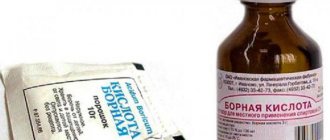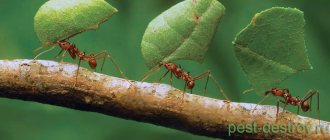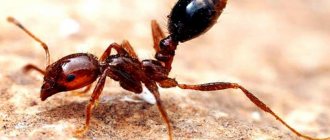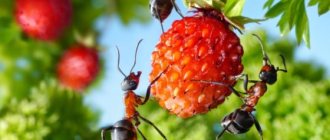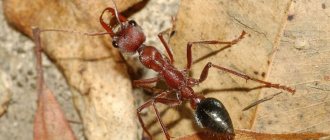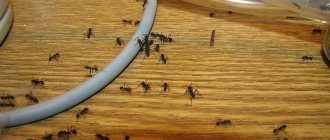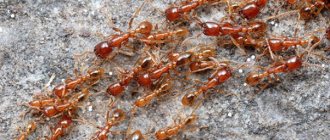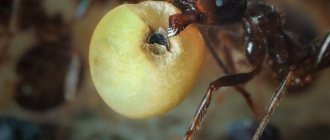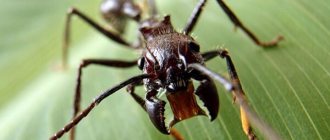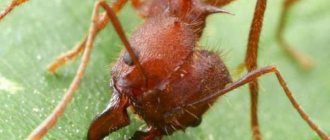Among solitary wasps there are insects that look and behave unusually. The European German is a species characterized by a velvety body cover, the absence of wings in the female and a parasitic lifestyle. Insects do not build their own nests, but attack others in order to lay their eggs there. Aggressive Germans are endowed with a toxic poison that helps them cope with other insects. When attacking a person, the bite site hurts for several hours.
Lifestyle
The flight of German wasps is observed from May to the end of August.
Adult insects feed on thistle, forest angelica. This is additional nutrition; after emerging from the pupa, the supply of nutrients is enough for 2 weeks. Males prefer sweet plant secretions. Females are found less often on flowers, but they are also not averse to tasting nectar. Wasps are not active throughout the day; they are active 4-5 hours a day. The ability of German wasps to inflict painful stings with their stings gave rise to various names “cow killer” and “mule killer”. In fact, insect venom is not enough to harm large animals. Red spots in the color of wasps warn others about its danger. The number of insects is affected by environmental pollution and negative changes in habitats. The European German species is listed in the Red Book of the Smolensk region. The number of insects in the region is still at a sufficient level, but there is a downward trend.
Features of reproduction
The European bird does not build its own nests, but is a parasitoid of lepidopteran and hymenopteran insects. Most often, wasps lay eggs on bumblebee larvae. Sometimes German bees attack honey bees Apis mellifera. Females run along the ground in search of the host’s nests; she uses sensitive antennae for location. They penetrate into the dwellings where the larvae have appeared and lay their eggs on them. After 3-4 days, the offspring of German females appear. The first instar larva has mandibles strong enough to gnaw through the host's integument (usually in the chest area) and begin feeding.
The host is completely eaten; the size of the future wasp depends on its size. The Germans who fed on bees were smaller than the insects that developed on bumblebees. Parasitoids overwinter at the pupal stage. They create their own cocoon inside the host. In spring, adults gnaw their way out. The males appear first and make frequent flights in search of females to mate with. During this period they feed on nectar. For females, it is more typical to suck the bodies of killed insects. Insects lead a secretive lifestyle, making them difficult to observe.
The danger of the black wasp
The black wasp is beneficial in the garden, but can harm a person if it bites him. Usually the bites are not fatal and the swelling subsides after 3-4 days, but if there is individual intolerance, this greatly complicates the situation. In this case, a person may die if he is not provided with medical assistance in time.
The pain of a pompilid bite is equivalent to the bite of a red ant.
Immediately after an insect attack, it is necessary:
- Disinfect the wound with peroxide and manganese.
- Apply cold to stop the penetration of toxins.
- Take an antihistamine to relieve swelling and redness.
- Drink tea, water, Regidron solution. A large amount of liquid will speed up the elimination of toxins.
Typically, an insect bite causes redness and burning at the site of penetration. Pain and swelling may vary in intensity depending on the individual characteristics of the victim’s body.
You should be wary if, after a bite, the swelling extends beyond the penetration zone, body temperature rises, shortness of breath appears, difficulty breathing, and blood pressure drops. All these symptoms indicate intolerance to poison.
In this case, you need to take an antihistamine and call an ambulance. It is especially dangerous if a wasp has bitten a child or a pregnant woman. In this case, anaphylactic shock can be fatal.
No less dangerous is a bite to the mouth, tongue, face, or neck. Severe swelling provokes suffocation, which also requires medical intervention.
NOT A PARASITE, BUT A PREDATOR
German bees parasitize the nests of various solitary bees (for example, Andrene ground bees), solitary wasps (burrowing wasps, or sphaecids, and road wasps, or pompilids), as well as social folded winged wasps. According to some reports, mutilids can also parasitize the colonies of honey bees and various types of bumblebees. In addition, representatives of other insect orders have been reported. This is a very wide range of hosts. The fact is that German women are not interested in the provisions stored by the owner, but in his offspring, which the parasite larva feeds on. Strictly speaking, it is incorrect to call German women parasites, since they are actually predators that kill their victims. The female searches for the owner’s nest and either enters it through the main entrance, or makes a dig - digs a separate hole leading to a cell with provisions and offspring. The female has a powerful stinger, which she is believed to use when encountering a host insect. However, in the sealed burrows of solitary bees and wasps there are only larvae and pupae, which cannot offer any resistance to the robber, and in the nests of social insects, where there are many warlike workers, even the strongest sting can hardly help in a collision with superior enemy forces. The German wasp pupates in the host's nest, and if it happens in a burrow, the young wasp makes an exit for itself in the ground.
INTERESTING FACTS
Parasitism is very widespread among hymenopteran insects that build nests and store food in them. A home with supplies in itself inevitably attracts thieves and robbers - if it were good, there would be hunters for it. There are parasites among both wasps and bees. The beautiful wasps alone, which parasitize the nests of many species of solitary wasps and bees, number about 3,000 species in the world fauna; parasitic wandering bees, or nomadines, number 1,200 species. Representatives of non-parasitic species are also prone to theft. So, at the end of summer - beginning of autumn, when there are few flowering plants, a weak family of honey bees in an apiary can be plundered by neighboring strong families, stealing all the honey from it. Representatives of parasitic species of wasps and bees are often strikingly brightly colored, much brighter than the host species on which the parasite feeds.
Schmidt scale
This led Justin to create his own pain scale for venomous insects, also known as the Schmidt Sting Severity Scale. There are four points on it, and it is based on the sting of an ordinary bee, which is familiar to almost everyone. A bee sting is worth two points. To be rated a point lower or higher, the bite must differ significantly in pain. If it is not different enough, it is assigned half the value.
Over many years of research, the entomologist added many more species of insects to his list, not only ants, but also bees, wasps and others. Of course, Schmidt was never particularly keen to experience the bites and effects of the venom of these insects, but in the course of his research he received more than a thousand bites from 83 species of stinging insects. It is not surprising that not only ordinary people, but also fellow entomologists listen to the words of such an expert.
Who eats wasps?
Despite the fact that most wasp species are aggressively colored predators, armed with a poisonous sting, and they have enemies. Among them:
- hornets (the closest relatives of some species turn out to be the worst enemies);
- praying mantises;
- fantail beetles (parasitic on larvae);
- ants (they destroy the homes of wasps, destroy weak and sick insects);
- birds (more than 100 species prey on wasps, the most famous are honey beetles);
- mammals (bears, badgers, weasels, rats, skunks, mice);
- lizards;
- frogs, toads.
Wasps are most vulnerable in the fall, when air temperatures drop and insects become less active.
Panda Ant and Bee Wolf
However, scientists have long united ants, termites, bees, wasps and bumblebees into the group of “social insects”, and they were included in the general order Hymenoptera. But I especially liked two varieties.
Bee wolf. Not a wolf and not a bee
They are also called philanthus - after the name of the genus Philanthus, which includes about 140 species. During the breeding season, female philants turn into ruthless killers. These are sand wasps (such a family), which for their colonies dig holes in sandy soils (up to a meter deep!) and hunt other insects - even beetles. The European bee wolf Philanthus triangulum (four of the five subspecies are found primarily in Africa) preys only on honey bees. Moreover, he hunts in order to make “canned food” out of them for his larvae - for one larva you need four to six bees.
Here's how it happens. The “wolf” grabs the bee and stings it directly in the chest – in the thoracic ganglion, which immediately paralyzes the victim. The bee cannot defend itself with its sting, as it bumps into the “armored” abdomen of the philanthus wasp. The “wolf” squeezes out the nectar from the bee and licks it (because, in fact, the wasp itself feeds on nectar) in order to neutralize the future “baby food”: for the larva, nectar is poison, and it’s also sticky, it can clog its spiracles. After this, the wasp takes the paralyzed insect to its hole and lays an egg on it. Then he brings five more and “seals” the hole. The hatched larva eats the bees, just like a “plant,” and grows. Special bacteria (streptomycetes that produce antibiotics) from the secretion of glands on the antennae help the wasp “preserve” each bee and extend its “shelf life” - by the way, the female treats the walls of her brood chamber with the same secretion to prevent the appearance of mold. Then the bacteria penetrate the larva’s cocoon and feed on its waste products. This symbiosis has existed for 68 million years - during this time the composition of antibiotics has remained almost unchanged.
Panda Ant. Not an ant and not a bear
Or "velvet ant". But this is not an ant at all! This is a wingless German wasp from Chile. It is black and white and fluffy, but very insidious - it parasitizes the nests of other Hymenoptera: its larvae devour other people's larvae and pupate there. The adult individual is harmless at first glance - it feeds on nectar, but because of its deadly bites, the “panda ant” was nicknamed the “cow killer”. The sting of the German wasp is longer and more powerful than that of other wasps and bees, but other insects cannot “bite” it itself: its durable shell gets in the way. All this is only about females - males do not have a stinger, but they have wings, so in the mating flight the male carries the female “in his arms.” And after mating, the female looks for someone in whose nest to lay eggs.
Our magazine MM
Origin of insects
The differences between a wasp and a bee are due to the characteristics of the habitat, climate, and genetic transformations. When comparing insects, it is necessary to take into account that in nature there are a huge number of them, but they all belong to the superfamily Apoidea. It brings together stinging Hymenoptera insects.
The following types of wasps are distinguished:
- Road (Pompilidae). Their natural habitat is Transcaucasia, Central Asia, North America, and Australia. They reach 3 cm in length, but there are also real giants up to 5.5 cm. These are solitary wasps that dig holes in the ground and lay offspring on the remains of stung spiders.
- True wasps (lat. Vespidae). There are about 4,800 species of this subfamily in the world. They have the usual striped color and live alone or in families.
- Spangled wasps (Chrysididae). Insects are distinguished by their beautiful bright colors and lead a parasitic lifestyle, using a bee, wasp or butterfly as a host.
- German wasps (Mutillidae) look a little like a fluffy bumblebee. They reach small sizes (up to 30 mm), and their distinctive feature is sexual dimorphism. German wasps lead a parasitic lifestyle, settling in the nests of bees, wasps or other insects. Germans have a dense shell and run quickly; their venom is low toxic, but causes severe pain.
- Sand wasps (Crabronidae) are small burrowing insects (up to 20 mm in length) called aphid hunters. Their families exhibit food specialization. Sandbills are excellent hunters; they quickly paralyze insects with poison and use them as food for their offspring.
- Scoliidae are insects that grow up to 100 mm. They are predominantly black in color, but may have bright yellow or reddish spots. Scolia larvae use other insects to grow, that is, they are parasites.
- Tiphia is a small wasp (up to 1 cm) with a black body and reddish legs.
- Flower wasps, Mazarinae (lat. Masarinae) are one of the most prominent representatives of the Hymenoptera. They have a bright color, feed on nectar, and are distinguished from bees by the way they transfer pollen - flower wasps use a crop. Females are solitary, build their own nests and prepare food for the larvae in the form of pollen and nectar. Flower wasps are rare because they live in desert areas.
The variety of insects is impressive, but just from the photos presented in the article, the difference between bees and wasps can be predicted: wasps are more graceful, with a thin “waist,” and bees, of which there are also many species in nature, have a different body structure.
Bees may belong to the following families:
- Andrenidae. This includes 2,900 species of bees that nest in the ground and live in large colonies. They are distributed throughout the world except Australia and Antarctica.
- True bees, or bees (Apidae) are a family that, among other 5,000 species, includes the honey bee and bumblebees. True bumblebees and bees are the main pollinators of plants, and the latter are also the main collectors of honey.
- Colletids (Colletidae) are low-organized insects of small size (5-15 mm). They nest in the ground, wood, and feed on nectar and pollen.
- Halictidae - settle in the ground and burrows, living in large colonies. The insects are black in color with a shiny reddish belly. Halictids are very common and often cause a nuisance by being aggressive and stinging without good reason.
- Megachilidae are small insects, predominantly black in color with bright stripes on the sides of the body. They settle in dry stems and rock crevices. Megachilids are the largest species of bees, reaching a size of 39 mm.
- Melittidae are medium-sized bees with a shaggy body. They nest in the ground and are one of the main pollinators of legumes and asteraceae.
- Stenotritidae are one of the rare species of bees that nest in the ground. They are distinguished by their large size and increased fluffiness.
In short, the similarities between a bee and a wasp are their small size, bright color, and way of defending themselves with a sting. In rare cases, wasps feed on nectar. There are much more differences between both representatives of the Hymenoptera.
Literature
Key to insects of the European part of the USSR. T. III. Hymenoptera. First part // Suborder Apocrita - Stalk-bellied (Arnoldi K.V. et al.) / under the general. ed. G. S. Medvedeva. - L.: Nauka, 1978. - P. 71–83 (Supersem. Mutillioidea - Lelei A.S.). — 584 p. — (Key guides to the fauna of the USSR, published by the Zoological Institute of the USSR Academy of Sciences; issue 119). — 3500 copies.
- Key to insects of the Russian Far East. T. IV. Reticuloptera, Scorpioptera, Hymenoptera. Part 1 / under general ed. P. A. Lera. - St. Petersburg: Nauka, 1995. - P. 202-211 (Fam. Mutillidae - Germans, or mutillids - Lelei A.S.). — 606 p. — 3150 copies. — ISBN 5-02-025944-6.
- Lelei A. S.
German wasps (Hymenoptera, Mutillidae) of the fauna of the USSR and neighboring countries. - L.: Nauka, 1985. - 268 p. — 1000 copies. - Leley A. S.
Catalog of German wasps (Hymenoptera, Mutillidae) of the Palearctic region. - Vladivostok: Dalnauka, 2002. - 171 p. — ISBN 5–8044–0280–3. - Leley A. S.
Catalog of German wasps (Hymenoptera, Mutillidae) of the oriental region. - Vladivostok: Dalnauka, 2005. - 251 p. - Leley A. S., Kabakov O. N. (1980). To the knowledge of wasps of the families Bradynobaenidae and Mutillidae (Hymenoptera) of Afghanistan
// Entomological Review. - T. 59. Issue. 1. pp. 181-196. - Brothers, D. J. (1975). Phylogeny and classification of the aculeate Hymenoptera, with special reference to Mutillidae.
// University of Kansas Science Bulletin 50: 483–648. - Manley, D. G. and J. P. Pitts. (2002). Key to the genera and subgenera of Mutillidae of America North of Mexico.
Journal of Hymenoptera research. 11: 72-101. - Manley, D. G. and J. P. Pitts. (2007). Revision of the Neotropical velvet ants of the genus Dasymutilla (Hymenoptera: Mutillidae).
Zootaxa, 1487, 1-128. - Nonveiller, G. Catalog of the Mutillidae.
Myrmosiciae and Bradynobaenidae of the Neotropical Region inclnding Mexico (Insecta: Hymenoptera). SPB Academic Publishing bv, the Netherlands, pp. 1–150. - Pitts, J. P. (2007). Revision of Odontophotopsis Viereck (Hymenoptera: Mutillidae), Part 1, with a description of a new genus Laminatilla
. Zootaxa, 1619: 1-43
Reproduction
Genetically, leaf-cutter ants are characterized by a diploid chromosome set - 2n = 38. Reproduction occurs similarly to other species of ants. At a certain stage, the caste of worker ants begins to fatten the larvae with the addition of special substances that stimulate sexual development. Females and males adapted for reproduction have wings. As soon as the number of such individuals reaches critical values, they fly out of the anthill, begin to swarm and mate.
Leaf cutters are not characterized by polygyny and therefore there is always only one queen in the anthill.
Some species of leaf-cutter ants have amazing abilities. In the event of the death of the only queen, the function of laying eggs is taken over by the workers. In this case, in some species, eggs produce males that are unable to perform the reproductive function, while in others, absolutely normal individuals emerge.
To collect a sufficient amount of seed, a swarming female mates with several males at once. Swarming lasts one day and ends with the death of the males. The female begins the process of oviposition in a hole dug by her. Several chewed and mycelium-infected leaves are also placed there. After 40–60 days, the first brood of working individuals appears, which take on all the “routine” work.
Reproduction and lifespan
Mating of the wasp nest queen, which occurs in the autumn, occurs sometime in October. The male individuals of these insects are usually called drones, just like bees. The purpose of such a colony caste is to copulate with the queen.
They have no other responsibilities. In the fall, the queen has contact with several drones at once, and when she receives their sperm, she stores it in her body until the next spring. The males, having fulfilled their natural purpose, soon die. And the uterus falls into suspended animation for the entire period of severe cold and cold.
With the arrival of warmth, she, waking up from hibernation, immediately begins the work of building a nest. What material is used to construct the home of an aspen family has already been described; it should only be added that, like bees, it consists of cells.
First, the queen looks for a suitable place for the nest, and then builds honeycombs. And this entire structure ultimately ends up suspended on a branch or in a hollow tree or, as often happens, on the ceiling or attic of some building. A wasp nest can be found attached to window frames, in gardens and forests, and in abandoned burrows of small rodents.
An egg is laid in each cell and develops over the next six days. Soon larvae appear in the honeycombs. First, the queen, and at a later time other family members, take care of their feeding. Their food comes from insects, thoroughly crushed by chewing.
As time passes, the next stage begins - the pupa. The larva turns into it, wrapping itself in a web. This is called a cocoon. After 3 days, the imago hatches from it, that is, the wasp in the adult stage.
Wasp mating
It should be noted that the eggs of these insects are not all the same. They may or may not be fertilized. The eggs of the first type produce a new queen and worker wasps. Here everything depends solely on the type of nutrition in the larval stage. Drones are given life by unfertilized eggs.
After the worker wasps emerge from their cocoons, the queen’s mission to build a nest and feed her offspring ends; now her only concern is new eggs, which she lays three hundred a day.
wasp insects take over the responsibilities of feeding the larvae . They build honeycombs and feed the queen herself. By the end of summer, worker wasps stop hatching; in the autumn, only females and drones are born.
In some cases, the queen may lay her eggs in the fall. The resulting new generation of wasps goes in search of a pair to mate outside of their native nest. After completing the mission, the males, as usual, die. However, such a fate does not befall females. They hibernate in order to form their own new colony in the spring.
The process of a wasp emerging from a larva
The queen lives the longest in the aspen family. Its lifespan is about 10 months. Worker wasps, like drones, live much shorter lives - about four weeks.
A BRIEF DESCRIPTION OF
Class: insects. Order: Hymenoptera. Family: German. Latin name: Mutillidae
. Size: from 5 to 30 mm. Color: males are brown or black with rusty-red spots on the chest, females with a reddish chest and a black and white pattern on the abdomen.
4 418
Early in his career, aspiring entomologist Justin Schmidt and his zoologist wife returned from a cross-country trip to the University of Georgia. They were collecting a collection of different species of harvester ants, which Justin describes in his book as “nasty stinging insects whose venom chemistry is unknown.” And to complete his dissertation, Justin needed to analyze a huge number of creatures and their bites.
After the couple managed to collect enough insects, they had to compare their poisons, analyzing the toxic effects and pain from the bite. This is how the Schmidt Pain Rating for Stinging Insects was born. The rating is a 4-point system, the starting point of which is the well-known honey bee (its sting is 2 points). A particular level of sting is assigned depending on how painful it is compared to a bee sting.
Over the years, Schmidt has added new insect species to his list. He was bitten more than 1,000 times by at least 83 different species of insects.
We have selected examples that best illustrate the full spectrum of pain.
Red fire ant
Scientific name: Solenopsis invicta.
Habitat: South America.
Description: “Sharp, sudden, slightly alarming pain. It's like walking on a shag carpet and then reaching for the light switch."
Pain level: 1.
Cicada Hunters
Scientific name: Sphecius grandis.
Description: “The pain comes immediately. Like poison oak, the more you rub it, the worse it gets.”
Pain level: 1.5.
Honey bee
Scientific name: Apis mellifera.
Habitat: Africa and Europe.
Description: “Burning, corroding pain, but you can handle it. It’s as if a flaming match head fell on your hand and was extinguished first with alkali and then with sulfuric acid.”
Pain level: 2.
Pennsylvania wasp
Scientific name: Vespula pensylvanica.
Habitat: North America.
Description: “Hot and burning, almost rough. Imagine comedian William Claude Fields putting out his cigars on your tongue.”
Pain level: 2.
Black polybia wasp
Scientific name: Polybia simillima.
Habitat: Central America.
Description: “A satanic ritual went wrong somehow. The gas lamp in the old church explodes in your face when you try to light it.”
Pain level: 2.5.
Female velvet ants are wingless wasps whose size ranges from small, like the 6mm Dasymutilla asteria (pictured), to huge, almost 25mm - the larger they are, the more painful they sting.
Velvet ant (actually a wasp)
Scientific name: Dasymutilla klugii.
Habitat: North America.
Description: “Explosive and long-lasting pain, you will not be able to stop yourself from screaming madly. It’s like hot frying oil is pouring all over your hand.”
Pain level: 3.
Florida harvester ant
Scientific name: Pogonomyrmex badius.
Habitat: North America.
Description: “The pain is sharp and merciless. It's like someone using a power drill is trying to dig out your ingrown toenail."
Pain level: 3.
Wasp - tarantula fighter
Scientific name: Pepsis spp.
Habitat: North, Central and South America.
Description: “A blindingly violent electric shock. It's like a running hair dryer just fell into your bathtub."
Pain level: 4.
Bullet Ant
Scientific name: Paraponera clavata.
Description: “Pure intense pain, like walking on hot coals with a 3-inch nail in your heel.”
Pain level: 4.
Armadillo wasp
Scientific name: Synoeca septentrionalis.
Habitat: Central and South America.
Description: “Torture. You are chained in the flow of an active volcano. Why did I start this list?
German wasp or velvet ant
Germans, or velvet ants (lat. Mutillidae) are fluffy wasps from the order of Hymenoptera insects. There are about 8,000 species and 230 genera known in the world. Fossil representatives of velvet ants were discovered in Dominican amber, 25-40 million years old.
These bright, fluffy insects have nothing in common with ants except their name. They were named velvet ants because of their thick hair, which is distinguished by a bright variety of colors, including white, blue, gold, black, silver, and red.
Their bright colors serve as a warning to other animals that these wasps may not be entirely friendly to their enemies. Germans are known for their extremely painful bites, jokingly said to be strong enough to kill a cow. To confirm this, we can recall another, unofficial name for these insects, known as “cow killers.” Of course, cattle do not die from the bites of these wasps, but they are guaranteed to experience pain.
Like all Hymenoptera, only the female is capable of inflicting a bite, since the sting itself is a modified female organ (ovipositor).
Adult velvet ants have a body length of 5 to 30 mm. In some species, males are so much larger than females that they can lift a wingless female into the air to mate. Males are dark in color: black or brown with reddish areas on the chest, while females are brighter in color - most often red-brown or red. They have a simple pattern on their abdomen.
But these are not the only sexual differences: males have eyes, but females have them reduced; in males the abdomen consists of seven segments, and in females - of six.
For humans, the pricks of these furry wasps are quite painful. The pain goes away only after a few hours.
UkhtaZoo
Morphological description of the species
The European wasp (Mutilla europeae) is one of 4 thousand species of the German wasp family. Insects prefer warm climates, arid steppes and semi-deserts. Stinging hymenoptera attract interest due to the striking differences in the appearance of representatives of different sexes.
Sexual dimorphism
Female . The insect's body length is 10-15 mm. The back of the head is widened, the forehead is convex. There is a red-brown spot on the crown. The eyes are medium in size, elliptical in shape, the ocelli are reduced. The antennae are 12-segmented. The main body color is black, the chest is rusty-red. The back is solid, not divided by grooves. The abdomen, consisting of 6 sternites, has a pattern of light spots or bands. The limbs are well developed; there are sharp spurs on the tibia of the middle and hind legs. The top of the head and chest are covered with short black hairs. The abdomen and limbs are covered with light hairs. There are no wings. Females have a sharp, powerful sting to protect them from enemies.
Information. Wingless females, running quickly through the soil and trees, resemble ants in appearance. They are called velvet ants for their thick and soft hair.
Males . Males are larger than females, their body length is 11-17 mm. On the sides of the black head are deep, hairless eyes. In addition to the main compound eyes, males have developed simple ocelli. The antennae are 13-segmented. The chest is often with a brownish-red spot and well-defined sutures. The body, legs and antennae are black. Front fenders with blackout. The abdomen consists of 8 visible sternites. There are light stripes on the 1st, 2nd and 3rd tergae. The body is covered with dark hairs.
Interesting fact. On the 2-3 sternum of the abdomen of males there is a stridulatory organ, with the help of which they make sounds that attract females. Females are also capable of making sounds when in danger.
Classification. (Classification)
There are 216 genera known, 30 subgroups and 4300 types OS-Germans from 8 subfamilies Brothers and Lelej (Brothers and Lelej), 2022. Previously identified from 7 to 10 subfamilies, and Myrmosinae moved from the Tiphiidae. part of the group Typhoctinae, Chyphotinae and Apterogyninae was allocated to a separate family Bradynobaenidae. In 2012, it gives 4285 species and 207 births, 2012 (By 2012) other information about 8000 species and 230 genera from 9 subfamilies, Manley and Pitts (Manley and Pitts) 2002. In 2022, we developed a new classification of 8 subfamilies and 216 valid genera: Myrmosinae with the tribes Kudakrumiini and Myrmosini, Pseudophotopsidinae, Rhopalomutillinae, Ticoplinae with the tribes Smicromyrmillini and Ticoplini, Sphaeropthalminae, Myrmillinae, Dasylabrinae with the tribes Apteromutillini trib. n (Apteromutillini tribes). and Dasylabrini and Mutillinae.
- Tribe Kudakrumiini or Kudakrumiinae Krombein, 1979.
- Pseudomyrmosa Suarez (Pseudomyrmosa Suarez), 1980.
- Myrmosinae Fox (Myrmosinae Fox), 1894.
- Protomutilla Bischoff (Protomutilla Bischoff), 1916.
- Erimyrmosa Lelej, 1984.
- Carinomyrmosa Lelej, 1981.
- Krombeinella Pate (Krombeinella Pate), 1947.
- Paramyrmosa Saussure (Paramyrmosa Saussure), 1880.
- Myrmosa Latreille (Myrmosa Latreille), 1796.
- Tribe Myrmosini Myrmosinae. (Tribe Myrmosini Myrmosinae)
- Pseudophotopsis Andre (Pseudophotopsis Andre), 1896.
- Pseudophotopsidinae Bischoff (Pseudophotopsidinae Bischoff), 1920.
- Ticoplinae Nagy (Ticoplinae Nagy), 1970 (Since 1970) SKO Smicromyrmillini and Ticoplini.
- Nanomutilla Andre (Nanomutilla Andre), 1900.
- Smicromyrmilla Suarez (Smicromyrmilla Suarez), 1965.
- Rhopalomutillinae Schuster (Rhopalomutillinae Schuster), 1949.
- Bischoffiella Brothers & Nonveiller (Bischoffiella Brothers And Nonveiller), 2015.
- Rimulotilla Brothers (Rimulotilla Brothers), 2015.
- Rhopalomutilla Andre (Rhopalomutilla Andre), 1901.
- Pherotilla Brothers (Pherotilla Brothers), 2015.
- Lomachaeta Mickel (Lomachaeta Mickel), 1936.
- Chilemutilla Cambra and Quintero (Chilemutilla Cambra and Quintero), 2007.
- Stethophotopsis Pitts and McHugh (Stethophotopsis Pitts and McHugh), 1999.
- Sphaeropthalminae Schuster (Sphaeropthalminae Schuster), 1949 1903. Previously, only 2 tribes of Pseudomethocini and 29 genera of Sphaeropthalmini and 39 births were recognized.
- Cystomutilla Andre (Cystomutilla Andre), 1896 Cystomutilla teranishii (Cystomutilla 1896 teranishii).
- Sphaerophthalma Blake (Sphaerophthalma Blake), 1871.
- Photomorphus Viereck, 1903.
- Pseudomethoca Ashmead, 1896.
- Stenomutilla Andre (Stenomutilla Andre), 1896.
- Jaxartilla Lelej, 1984.
- Dasylabris Radoszkowski, 1885.
- Tricholabiodes Radoszkowski, 1885.
- Dasylabrinae Skorikov (Dasylabrinae Skorikov), 1935 with SKO Apteromutillini and Dasylabrini.
- Orientilla Lelej, 1979.
- Sigilla Skorikov (Sigilla Skorikov), 1927.
- Odontotilla Bischoff (Odontotilla Bischoff), 1920.
- Myrmilla (Wesmael Myrmilla), 1851.
- Myrmotilla Bischoff (Myrmotilla Bischoff), 1920.
- Myrmillinae Bischoff (Myrmillinae Bischoff), 1920.
- Spilomutilla Ashmead, 1903.
- Bischoffitilla Lelej, 2002.
- Liomutilla Andre (Liomutilla Andre), 1907.
- Platymyrmilla Andre (Platymyrmilla Andre), 1900.
- Blakeius Ashmead, 1903.
- Smicromyrme Thomson (Smicromyrme Thomson), 1870.
- Odontomutilla Ashmead, 1899.
- Ctenotilla Bischoff (Ctenotilla Bischoff), 1920.
- And another view. (Another kind)
- Nemka Lelej (German Lelej), 1985).
- Yamanetilla Lelej, 1996.
- Mutillinae Latreille (Mutillinae Latreille), 1802.
- Mutilla Linnaeus (Mutilla Linnaeus), 1758.
- Karlidia Lelej, 1999.
Unusual animals #1
Panda Ant
Among the most unusual animals on the planet is a furry creature with the coloring of a panda. In fact, this is not an ant, but a wingless wasp that lives in South America. It is very similar in appearance to an ant, but, unlike it, it has a powerful sting.
External signs of a panda ant
The panda ant is covered with thick hairs, which is why it is also called the velvet ant. The males and females of this species are so strikingly different from each other that they are mistaken for separate species of insects. The Panda ant displays pronounced sexual dimorphism.
Males are several times larger, reaching a body length of 3–8 mm. They have developed wings, but fewer hairs on their body.
The color of the insects is black, with very bright red, orange, yellow or white areas. The head is large with white hair. Females are wingless, like real ants with bright colors, densely covered with hairs on the head, chest, and abdomen, which give them a velvety appearance. The sting is long and smooth.
Distribution of the panda ant
The panda ant lives in Latin America and is found in the coastal zone of central Chile. It is also believed to be currently spreading in Argentina, the United States of America and Mexico.
Panda Ant Habitats
The panda ant inhabits open, desert regions with dry, hot climates
Panda ant is a poisonous insect
Panda ants have a powerful toxin that can kill a cow after a few dozen bites. Therefore, local residents nicknamed them “cow killers.” Velvet ants can cause a lot of problems even to humans with their bite. The pain at the site of the poison does not go away within several hours.
Panda Ant Reproduction
After mating, the female searches for a nest of hymenoptera insects, which is inhabited by bees and sphecoid or folded-winged wasps. Unnoticeably enters someone else's home through the main entrance or creates a tunnel if the shelter is on the ground. Lays eggs in a cell where the larva or pupa of the host insect lies.
German wasps openly parasitize other people's offspring and never build their own nests. In addition, they eat nectar mixed with pollen, prepared by other species of Hymenoptera to feed their own offspring.
In a motionless state, immured in wax, they do not resist and become victims of velvet ants. When the panda ant larvae emerge from the eggs, they will begin to eat the larvae of the nest owners.
The larvae of panda ants turn into pupae, from which adult wasps emerge - German wasps. If the host's nest is in the soil, then the young German wasp breaks through a separate exit to get out.
The winged males emerge first, the females emerge later. It is impossible to get rid of the parasites, since the invaders have long and sharp stings compared to other Hymenoptera.
Panda Ant Lifestyle
Male panda ants are nocturnal. Females are usually active during the day. They are also found on plants, but much less frequently, eating males.
Insects often burrow into sand or dry, loose soil.
Panda ant nutrition
The panda ant feeds on sweet juice - nectar.
Interesting Facts
The "Velvet Ant" or "Panda Ant" comes to live for about 2 years.
The panda ant has a potent toxin.
The panda ant is actually just a wingless species of wasp.
Basic characteristics of the wasp
What a wasp looks like is largely determined by what species it belongs to. However, regardless of species, all insects have common features. The body of an insect consists of 3 main parts:
- head;
- breast;
- abdomen.
The chest and abdomen are connected by a thin bridge. On the head there are convex compound eyes, between them on the top of the head there are 3 simple eyes, antennae, and an oral apparatus in the form of powerful, strong jaws. There are 6 legs on the chest, each of which consists of 5 segments. The wasp performs many different actions with its legs, for example, holding on to a flower while drinking nectar, or digging a hole.
Appearance
These insects have 2 pairs of wings. Most often they are transparent, thin, with pronounced veins. The front ones are noticeably longer than the rear ones. On the lower part of the abdomen there is a thin, sharp, smooth sting connected to a gland that produces a poisonous substance. The sting is used for both self-defense and attack.
The traditional color of the wasp is black and yellow, but there are many species whose representatives are colored differently.
